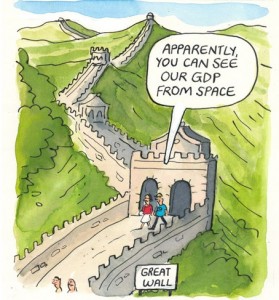Zhang Jun writes: Many people are profoundly pessimistic about the Chinese economy’s growth prospects, owing to the emergence of massive debt, excessive investment, overcapacity, and so-called “ghost cities” since the 2008 global financial crisis. But these problems are not new. They have, in various forms, affected China’s economy since 1978, and were evident in East Asia’s other high-performing economies – Taiwan, South Korea, and even Japan – during their periods of rapid growth.
How did these economies manage to grow so fast for so long and overcome the serious problems that they faced along the way? The answer is simple: resilience.
If a country fails to respond adequately to new challenges as they arise, economic growth and development stall. East Asia’s economies have consistently adjusted their growth strategies and engaged in continuous institutional reform. The aim was not to tackle the problems they faced directly, but to induce new, more efficient activities that would help to turn debt into assets and maximize use of the economy’s capacity.
East Asia’s economies have embraced the process of “creative destruction” described by the Austrian economist Joseph Schumpeter, whereby the economic structure is continually revolutionized from within. By implementing incremental reforms that facilitate the replacement of old, inefficient sources of growth with new, more dynamic ones, they have expedited this process.
China’s productivity-enhancing agricultural reforms in the 1980s were spurred partly by growth in the non-agricultural sector, a result of policies aimed at stimulating township and village enterprises. Similarly, in the 1990s, China addressed the buildup of bad debt and unfinished construction projects by implementing institutional reforms that stimulated growth in more dynamic sectors, thereby offsetting the SOEs’ declining return on capital.
Resilience has thus characterized the interaction between the government and markets since the introduction of Deng’s reforms.
In China clusters of vibrant smaller manufacturers are flourishing. Market institutions guide the process, ensuring that they play a key role in the expanding industrial sectors.
Another source of resilience in East Asia are local governments. They are responsible for public capital expenditure, driving the improvement in China’s physical infrastructure and yielding reasonable returns for private investors. This advances the objective of helping local businesses, particularly innovative small and medium-size firms, to grow and thrive.
Finally, local governments have demonstrated a willingness to support institutional innovation. This allows for the flexibility needed to address structural challenges at the local level, thereby preventing them from blocking growth.
After three years of slowing growth and rising debt, China once again finds itself at a crossroads. Fortunately, it seems to be choosing the path of flexibility and adjustment, as it pursues an ambitious reform plan that, it is hoped, will enable it to edge closer to – and eventually cross – the high-income threshold.

